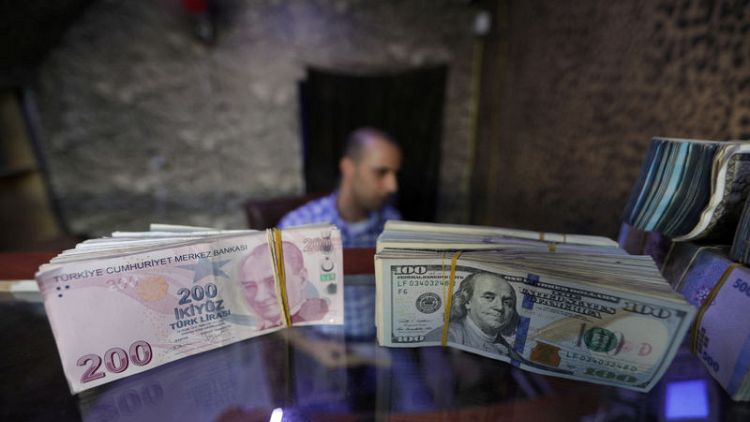By Karin Strohecker and Marc Jones
LONDON (Reuters) - Having suffered its worst year in nearly two decades in 2018, Turkey's lira was earmarked by many as the "comeback kid" of this year - with local policymaking getting the benefit of the doubt at last and global currency markets calming.
But January so far has proved a far more uncomfortable affair.
Turkey's toxic cocktail of regional political tension, domestic governance worries and monetary and fiscal policy uncertainty continues to frustrate any attempted rebound.
And the hangover from the 2018 currency collapse has still to hit the local economy with full force, testing the central bank's resolve in being able to keep interest rates at current punitive levels to defuse the lira-fuelled inflationary surge.
Rising tensions with its NATO ally, the United States, fears that the central bank could cut rates too early - it meets for the first time this year on Wednesday - and a government willing to loosen the purse strings in the run-up to municipal elections in March have seen the lira underperform its peers.
"If the market concerns subside in the coming days, then maybe the lira would stabilize as well, but I think what is more important is the continuation of these factors, and some of them will be with us clearly for the time being," said Inan Demir at Nomura.
Below are five charts that illustrate the recent selloff and foreign investors' involvement in Turkey's $631 billion economy.
LANGUISHING LIRA
Following six straight years in the red, the lira has slipped 3 percent year-to-date, making it the worst performing emerging market currency so far in 2019.
The latest relapse started when Japanese retail investors, who had put money back at stake in Turkey in late 2018, sold out dramatically on Jan. 3, pushing the lira nearly 10 percent lower against the yen. According to Tokyo Financial Exchange data, Japanese retail investors cut net lira long positions by 42,743 contracts that day, the most since the August 2018 selloff.
"Japanese retail investors whose appetite for carry trade offered by EM currencies tends to cause havoc when inevitably they get caught on the wrong side of the trade by market volatility," said Rabobank's Piotr Matys.
Japanese investors in Turkey: https://tmsnrt.rs/2AL6AUe
SULTRY STOCKS
Turkey's $109 billion stock market had a difficult 2018, falling 20 percent in lira terms.
Stocks and debt suffered net sales from foreign investors last year, according to Institute of International Finance data. The last time both asset classes saw outflows was during the 2015 crisis. Equities haemorrhaged over $1 billion (£785 million) in 2018.
Central bank data show that trend continued in 2019: Non-resident net-transactions recorded an outflow in shares and domestic debt securities in the week ending Jan. 4.
Turkey foreign fund flows png: https://tmsnrt.rs/2SRMQ8p
DEAR DEBT
Assessing deviations from long-term averages for Turkish government bonds, J.P. Morgan found Turkey's 10-year government bonds to be the most expensive in the world. Deutsche Bank warned this week Turkish debt was on its list of things to avoid.
Real returns on Turkish government debt are deeply negative with 10-year government bonds yielding 15.7 percent, while inflation stood a touch over 20 percent.
J.P.Morgan bonds: https://tmsnrt.rs/2H2rYdl
GRATING RATINGS
Turkey saw a rash of rating downgrades from the main agencies last year as its woes escalated. S&P Global, traditionally the most aggressive in its moves, cut it twice in three months as did Moody's. But Moody's and Fitch's score are still S&P's B+ rating, so there could be some more to come.
Is the Turkey shock done? "From a macro perspective maybe there's a little bit more to come," said Fitch's chief sovereign analyst James McCormack. "We will be focused on the public finance implications."
Turkey rating downgrades might be done: https://tmsnrt.rs/2HaPqVP
VOLATILE TIMES
Derivatives markets used by traders to bet on or hedge against currency swings point to a calmer time for the lira this year, albeit not completely calm.
Implied volatility options covering all the way from next week to next year are at less than half the level they were back in August at the height of the lira meltdown. They are, however, still double where they were this time last year when emerging markets were still on the surge globally.
Turkish lira implied volatility vs Mexico and Brazil: https://tmsnrt.rs/2SSk2N6
RATE EXPECTATIONS
Turkey's central bank is expected to keep its main rate at 24 percent on Wednesday. However, with inflation falling fast, a long record of surprising markets and a president advocating low rates, experienced Turkey watchers fear it could cut soon, even if not this time.
How soon and how deep it cuts will be key to both lira and bond market performances.
A survey published by the Turkish central bank last week showed expectations for rates to drop 4.5 percentage points to 19.5 percent over this year. Money markets, although sometimes volatile, are not predicting such a dramatic move, instead pointing to a fall to 22-23 percent. <0#TRYAM3LFSSM>
Turkey money markets point to rate cuts: https://tmsnrt.rs/2HdPuEi
(Reporting by Karin Strohecker and Marc Jones in London, additional reporting by Hideyuki Sano in Tokyo; Editing by Mark Heinrich)



